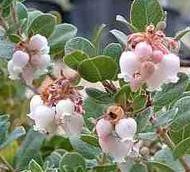Little Sur manzanita
(Arctostaphylos edmundsii)

Description
Arctostaphylos edmundsii, with the common name Little Sur manzanita, is a species of manzanita. This shrub is endemic to California where it grows on the coastal bluffs of Monterey County. This is a petite, low-lying manzanita which forms mounds and patchy mats in sandy soil. The leathery leaves are small and rounded to oval, dark green and shiny when mature and red-edged when new. The inflorescences are dense with flowers, which are small, urn-shaped to rounded, and waxy white to very pale pink. The fruit is a shiny, reddish-brown drupe between one half and one centimeter wide. It is a perennial shrub. Arctostaphylos is a genus of plants comprising the manzanitas and bearberries. They are shrubs or small trees. There are about 60 species, of Arctostaphylos, ranging from ground-hugging arctic, coastal, and mountain species to small trees up to 6 m tall. Most are evergreen (one species deciduous), with small oval leaves 1–7 cm long, arranged spirally on the stems. The flowers are bell-shaped, white or pale pink, and borne in small clusters of 2–20 together; flowering is in the spring. The fruit are small berries, ripening in the summer or autumn. The berries of some species are edible. Arctostaphylos species are used as food plants by the larvae of some Lepidoptera species including Coleophora arctostaphyli (which feeds exclusively on A. uva-ursi) and Coleophora glaucella. Manzanitas, the bulk of Arctostaphylos species, are present in the chaparral biome of western North America, where they occur from southern British Columbia in Canada, Washington to California and New Mexico in the United States, and throughout much of northern and central Mexico. Three species, the bearberries, A. alpina (alpine bearberry), A. rubra (red bearberry) and A. uva-ursi (common bearberry), have adapted to arctic and subarctic climates, and have a circumpolar distribution in northern North America, Asia and Europe. An unusual association of manzanita occurs on Hood Mountain, in Sonoma County, California, where stands of pygmy forest dominated by Mendocino cypress are found. One fossil fruit of †Arctostaphylos globula and several fossil fruits of †Arctostaphylos menzelii have been described from middle Miocene strata of the Fasterholt area near Silkeborg in Central Jutland, Denmark. Cultivation is generally difficult due to fungal diseases, and often salinity and alkalinity. Overhead watering should be avoided in hot weather. Some cultivars are easier to grow.
Taxonomic tree:







